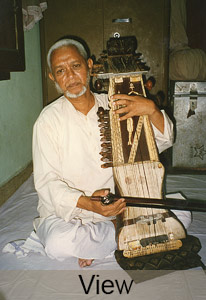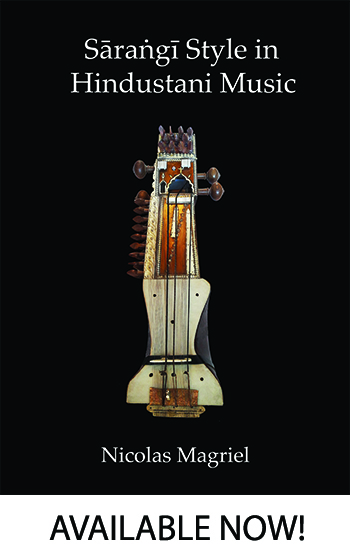
Ustad Mohammed Ali Khan was a rare sarangi player, an eccentric musicians' musician. I met him in 1995 at a lunch feast at the house of Ghulam Sabir in Delhi. He modestly invited me to his house in Old Delhi, saying he could show me a thing or two. Did he ever! His house is (it should be) a pilgrimage place for sarangi players—the haweli of the great Mamman Khan, the ustad (teacher) and father-in-law of the immortal Bundu Khan. Mohammad Ali Khan was the grandson of Kale Khan who was one of Mamman Khan's three brothers. As a child he had spent a lot of time listening to Bundu Khan's sarangi and his "jute-wute kahaniya"—crazy stories.
He had had a stroke several years before I met him, so was another sarangi player who was not 16-annas-to-the-rupee. But this made for fantastic teaching. He would sit for hours yelling tans at me, trying to plant Bundu Khan's tan style in my brain. He also taught me many complex paltas, note perrmutation exercises which were a speciality of his family. One day he reached under his bed and produced an ancient diary in which he had written 1001 paltas, mostly long and complex. He bundled us into a riksha, and we went off to photocopy it for me. This book is a masterpiece of stream-of-consciousness musical thinking. I have since analysed it and found that, although they are organised extremely randomly and illogically, after standardising them so that the lowest note of the first-position palta is Sa and so they are all in the same scale, there are still over 800 unique paltas amongst them. My paper "Paltas: maps of tonal space" which analyses many aspects of the palta phemomenon will eventually be published on this site.
Mohammed Ali Khan was a player of the sursagar, a sort of giant sarangi that also had a top-course of melodic strings that could be plucked like a swarmandal, and also some chikari strings running along the side of the fingerboard which he plucked with his little finger between bowed melody notes. He had not owned a sarangi for many years, and his sursagar was in a terrible state of repair. Two of the bone bridges, having been broken, had been replaced with cast aluminium bridges, and there was a generally chaotic feel to the way that the instrument's many strings and bridges were laid out.
In our lessons he would usually sing, or we would pass my sarangi back and forth. His neurological condition was such that sometimes his playing was embarrassing—but other times I felt I was sitting in the same room as Bundu Khan. He was a master of Bundu Khan's unique fingering techniques which often involved the rapid alternation of two fingers, similar to sitar usage.
Our lessons, if in the morning, were exhausting, but his wife would often terminate them, bringing in a huge pile of roties and the most delicious mutton curry I've ever tasted. He was also teaching his grandson Jaavad on the violin—mostly paltas—screeching away very fast and totally out-of-tune. I respectfully asked him "don't you think he should pay some attention to intonation?" He said "no no that will come of its own accord". I am curious whether it has indeed come for Jaavad.
Mohammed Ali Khan was hard of hearing, and he had a terrible hearing aid, purchased on some streetcorner for fifty rupies. It just rang and echoed in his ear, so he kept it turned off. One day I collected a highly-respected ear doctor from New Delhi and dragged him to his house in Sui Walan on a riksha. She seemed like she'd never been on a riksha before, certainly never in Old Delhi. She was more than a little nervous. When we arrived, Mohammed Ali Khan implored her to have lunch (she was a Hindu vegetarian) and when she wouldn't have that, forced tea and chaklis on her. She was desparate to test his ears and escape. Anyway I delivered his new high-tech hearing aid a week later. Over the coming weeks I noticed that he wasn't using it. The truth of the matter was that he kept it turned off so that he wouldn't have to listen to his wife's nagging. What a man! I really loved him.
.jpg) Several years after Mohammed Ali Khan's passing away in 2002, I purchased his sursagar from his wife. It is huge and extremely heavy. I nearly died sitting in the July sun in Delhi waiting for some carpenters to build a coffin in which to send it back to Bombay, where I was staying in 2006. In Bombay, I abandoned the coffin and brought the sursagar back to the UK in a giant cricket bag. It sat idle for a few years before I had the courage to violate its chaotic sanctity and repair it. I spent much of the summer of 2013 totally renovating it, making all new bridges, making it a beautiful and very playable instrument. It has a profoundly ethereal and introverted sound—perfect for dhrupad.
Several years after Mohammed Ali Khan's passing away in 2002, I purchased his sursagar from his wife. It is huge and extremely heavy. I nearly died sitting in the July sun in Delhi waiting for some carpenters to build a coffin in which to send it back to Bombay, where I was staying in 2006. In Bombay, I abandoned the coffin and brought the sursagar back to the UK in a giant cricket bag. It sat idle for a few years before I had the courage to violate its chaotic sanctity and repair it. I spent much of the summer of 2013 totally renovating it, making all new bridges, making it a beautiful and very playable instrument. It has a profoundly ethereal and introverted sound—perfect for dhrupad.
Most of the videos here are of our lessons, but there are some of him playing his sursagar or my sarangi or just talking. The first set here is from May 31, 1997. This gives some idea of his style of being: he moves rapidly between teaching me various bandishes, performing on the sursagar, and talking about music and life. It was exhausting. He had much more energy than I had—not at all phased by the intense heat of Delhi at the hight of summer. The first video is of various bandishes in Bhairav including a wonderful tarana:
Now we have some explanations of bandishes in Darbari interspersed with some beautiful sursagar playing. The gestalt of Bundu Khan's Darbari shines through, and you can see some of the unusual fingering techniques of this tradition:
Rag Jaitashri:
Rag Chandani Kedar—again very close to Bundu Khan's style:
Here we see Mohammed Alki Khan teaching me tans, supervising my tan practice in Bhairav. This was one of his early attempts to extract the relentless circular tans of this style out of me. Not great to listen to—I was hot and tired and the instrument was out of tune, but this gives some idea of his teaching style and of his conception of non-stop tan generation.
Z


